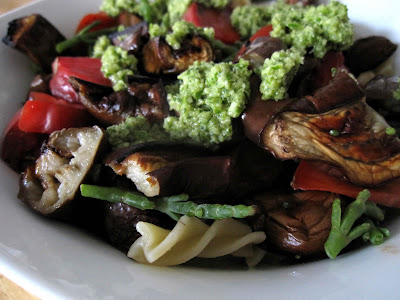Weird and Wonderful: Three Spring Treats
I always like a good surprise and this past weekend I found three in the form of produce. Two of them you may have heard of or even tried. I'm pretty sure that the third is something completely new to anyone but the growers and sellers and a few chefs in the area.
First up is a rare treat if you're a garlic lover: garlic scapes. These thick, curly cues of deliciousness are hard to find in San Diego. Last year I found them at First Korean Market on Convoy near Jasmine in Kearny Mesa. They were there just a brief time in the spring and that was it. On Sunday I found them at the Hillcrest farmers market at Sage Mountain Farm's stand and immediately snatched up a bunch, along with some first-of-the-season heirloom tomatoes, elephant garlic and a bunch of lovely multi-colored carrots.
Garlic scapes are the flower stalks that grow out of the garlic bulb. As they grow they begin to curl, and ultimately develop a little bud. They have just a brief season so get them while you can.
Some say they are milder than garlic bulbs, but they can be pretty potent while raw. Once cooked, however -- at least in my experience -- they lose a lot of that garlic flavor. So, my favorite way to use them is to make pesto. Simply chop them into smallish pieces and drop in the food processor. Add grated parmesan cheese, toasted pine or walnuts, salt and pepper and slowly drizzle in really good extra virgin olive oil until the mixture becomes creamy. In this batch above, I also added fresh thyme from my garden and about a tablespoon of fresh lemon zest.
The pesto is terrific on baked chicken, fish, grilled beef and pork. Add it to an omelet or roasted vegetables -- especially roasted potatoes, eggplant, tomatoes or summer squash. And, of course, it's a no brainer with pasta. I chopped some heirloom tomatoes and sea beans (see below for the big surprise), and roasted a couple of Japanese eggplants I bought at the City Heights farmers market.
The result was a wonderful vegetarian pasta dish that made two meals. And it was just as good cold as warm.
Okay, I mentioned the sea beans here and on Twitter. They're definitely a curiosity. I learned about them at Specialty Produce with L.A. food writer Erika Kerekes, who was visiting for the day. Specialty's Kelly Orange was showing us around and we walked by a large plastic bag of these greens on a shelf. They look like little twigs, but have a crispy texture and very salty, really briny, flavor straight out of the sea. Sea beans, also known as glasswort, grow wild on beaches and marshes, including estuaries in San Diego.
Part of the charm of these vegetables is their crispiness so I would use them fresh or maybe pickle them. But, certainly, you can saute or steam them or use them however you would any other vegetable. Make a salty pesto with them. Or just use them as a very interesting garnish. I added them to my pasta and looking forward to experimenting with them further.
While I was at Specialty Produce, I noticed they had pink lemons -- something I'd never seen. So I took home several to try. They're a variety unique to the average Eureka lemon. They start out with a very pretty yellow-and-green variegated skin but the flesh inside is pink and so they're often used to make pink lemonade. As the fruit matures, the skin starts to flush, as you can just see in the photo below. This is the result of lycopene, which also colors pink grapefruit.
Use these lemons just as you would a regular Eureka lemon. I thought they were too pretty to just squeeze and toss, so I made another jar of preserved lemons. If you haven't done this yet, give it a try. All you need are lemons, sea salt and a wide-mouth sterile jar.
First, cut the lemons vertically half-way down on one side, then flip the lemon over, do a half turn and make another cut. Then, stuff the inside of the lemon with the salt on each side.
Fill the jar as you stuff each lemon with the salt and press down to release the juice and make room for the next lemons. By the time you fill the jar, you should have no room for more lemons and they should be sitting in juice. If they don't release enough juice, squeeze more lemons and fill the jar with the juice to the top. Then, all you do is secure the lid and let the jar sit on your kitchen counter for a month to six weeks. Periodically turn the jar over and back upright to remix any salt that's settled at the bottom. If the lemons begin to collapse, you can add more split and salted lemons so the jar remains full.
At the end of a month to six weeks, you'll have a wonderful condiment to include in pastas, sauces, salads and sautes. Keep the jar refrigerated and pull out what you need. Trim away the flesh, rinse the peel and chop it. It adds a wonderful salty, sour flavor. But, remember, a little goes a long way for the best effect.
Print Page

![Reblog this post [with Zemanta]](http://img.zemanta.com/reblog_e.png?x-id=7bba8e52-4793-4b04-b124-cd7b8bafda62)











Very fun. I've had garlic scapes here, but of course there are no sea beans and I haven't ever seen this type of lemons either. I bet the preserved lemons are going to be amazing!
ReplyDeleteOk thats it, I have to get to speciality produce quicksmart. I love sea beans (or samphire as we used to call the stuff we had in Norfolk, UK).
ReplyDeleteThat sounds like a lot of those ingredients would go good with some grilled foods.If you would like to see the collection of tips and recipes I have for grilling you can visit www.cookingandgrillinoutdoors.com
ReplyDelete